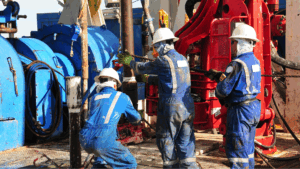A recent Dallas Federal Reserve survey, highlighted in Gas Outlook, paints a sobering picture of the current state of U.S. oil and gas drilling. Operators across the board are pulling back: rig counts are down, development plans are being scaled back, and confidence in a near-term rebound is low. While the reasons vary—from soft oil prices and rising steel costs to water management challenges in the Permian—the result is clear: a notable pause in upstream momentum.
Yet amid the slowdown, there’s also recalibration. For those in the middle market—private operators, investors, and mineral owners—this shift is not just a retreat; it’s a reset. The macro conditions may be difficult, but they also present a moment to reassess asset value, optimize portfolios, and prepare for a more selective cycle of dealmaking.
Pressure Points Defining the Market
The Dallas Fed’s findings reflect what many in the field are experiencing firsthand:
-
Oil prices stuck in the mid-$60s are not sufficient for aggressive drilling in many shale plays.
-
Tariffs on steel have raised well costs by as much as 8–10% for some producers, squeezing already-thin margins.
-
Water disposal and sourcing issues—particularly in the Permian—are straining infrastructure and budgets.
-
Private service companies are under increasing stress, raising questions about long-term field support capacity.
As a result, nearly half of surveyed producers expect to drill fewer wells this year than initially planned, and more than 60% indicated that if prices stay around $60/barrel, activity will continue to decline.
This contraction isn’t just about economics—it’s about operational confidence. And confidence, especially in the middle market, plays a critical role in how assets are valued, traded, and positioned.
What It Means for Middle-Market Participants
While large public operators can pause and wait out volatility, smaller players must often make more immediate decisions. This is where the slowdown becomes especially relevant for middle-market strategy.
1. Selective Deal Flow Over Broad Expansion
In a quieter market, the deals that do surface tend to be more intentional. Sellers aren’t rushing, but they are willing to part with non-core assets—particularly those with rising costs or operational complexity. For buyers with a long-term horizon, this environment favors targeted acquisitions rather than aggressive land grabs.
2. PDP-Weighted Assets Gain Appeal
With drilling slowed and uncertainty around new development, many investors are favoring proved developed producing (PDP) assets. These deliver steady cash flow with limited operational risk and are especially attractive for groups that prioritize yield over speculation.
3. Operational Efficiency Becomes a Key Differentiator
In today’s environment, basin knowledge, cost control, and infrastructure access matter more than ever. Deals involving assets with simplified logistics and proven uptime are moving faster than those requiring significant rework or infrastructure buildout.
A Ground-Level Perspective
At Eagle River Energy Advisors, we’re seeing this shift play out in real time. As deal volume has narrowed, the focus has sharpened. Buyers are asking smarter questions about asset performance and cost exposure. Sellers are adjusting pricing expectations and timelines, but many remain open to conversations—especially when the approach is informed, respectful, and grounded in real operating context.
Rather than viewing the current environment as a downturn, many of our clients are treating it as a strategic pause—a time to optimize holdings, clean up portfolios, or prepare for future opportunities that may arise as macro conditions shift.
Looking Ahead: Disciplined Growth in a Measured Market
While drilling may not rebound in the second half of 2025, activity in the M&A space isn’t disappearing—it’s evolving. We expect:
-
A continued trickle of asset divestitures from overextended private operators
-
Increased focus on gas-weighted properties as LNG export capacity grows
-
Potential restructuring opportunities as smaller service providers exit the market
For middle-market participants, this isn’t a time to rush—it’s a time to be ready. The companies and investors who remain engaged, informed, and disciplined are the ones best positioned to benefit when the next growth cycle emerges.
At Eagle River, we specialize in navigating complex oil and gas transactions in this part of the market—offering insight, clarity, and execution support when it matters most.




